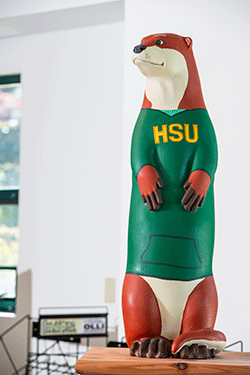The much-anticipated North Coast Otters have arrived! The North Coast Otters public art festival, treasure hunt, and online auction began in June.
North Coast Otters Public Arts Initiative is a community “treasure hunt” tour of more than 100 sculptures painted by local artists, with an aim to celebrate life, water, and otters, support local businesses, and raise funds for student projects. Visit the North Coast Otters Public Arts Initiative website for more information.
North Coast Otters merges art and science, encouraging imagination and observation from our region’s rich creative community.

The project commissioned 108 unique pieces of Otter Art now displayed at shops, galleries, schools, and other North Coast locations. Participating artists decorated three-foot-tall otter sculptures for an educational art trail throughout Humboldt, Del Norte, Mendocino, Trinity, and Siskiyou counties.
Use the maps and guidebooks to locate the otters. Learn all about the charismatic critter, which shares our wild rivers, coastlines, and wetlands. A Junior Otter Spotters “activity booklet” will be available to inspire the young and young at heart.
Otter Art sculptures are available for bidding in a silent auction online throughout the summer, and the highest bid sculptures will be sold in a live auction in September. Proceeds will go to HSU otter research and student internships with community-based watershed projects.

A guidebook—available at each host location and downloadable on the website—shows locations of participating shops, restaurants, and visitor centers. This public arts initiative provides an accessible opportunity to explore our connection with the natural world.
“The initiative arose from a desire to share what we are learning about wild river otters with the community,” says Jeff Black, HSU Wildlife professor and project lead. “River otters are at the top of the food chain in coastal watersheds, rivers, and wetlands, and just like us, river otters need clean water and fresh food each day.”
The project encourages community members to participate in the ongoing citizen science river otter records study by consistently reporting when and where wild river otters are observed throughout the North Coast region.
Since 1999, HSU students have been collecting otter records from citizen volunteers as a means of tracking the quality of North Coast habitats. River otters, seen at all times of day in our area, have captured the attention of thousands.
“Some of these wild river otters travel far and wide to find enough food each and every day,” Black says. “River otter numbers are beginning to recover thanks to efforts to restore and clean up habitats, but they need our commitment to ensure their presence in the wild.”

Send details of wild otter observations to otters@humboldt.edu or call (707) 826-3439.
——-
About the North Coast Otters Public Arts Initiative
North Coast Otters Public Arts Initiative provides a delightful opportunity for the community to learn about and appreciate the significance of this charismatic animal in our region’s clean water habitats. Artists share their vision of our connection with nature through art and science. Partners, sponsors, and hosts of the Otter Art will benefit from an enhanced association with community members and visitors. Proceeds will enable student opportunities and community-based watershed projects that lead to a better connection with our natural world.
Humboldt Patrons & Partners
Arcata Animal Hospital, Footprint Foundation, Get Ready Humboldt, Humboldt State University’s Sponsored Programs Foundation, McLean Foundation, and partnership group including Fortuna City, Chamber of Commerce, Housing Alliance, and River Lodge.
Black Dog Woodworks, Crescent City Art & Del Norte County Unified School District, City of Eureka Planning Office & Arts and Culture Commission, Ink People & North Coast Open Studios, Alan Peterson’s Redwood Planet Media & Will Goldenberg Film, The Art of Fundraising, Jolly Roger Lifesize Models & Galabid, and over 100 contributors from the community.
About River Otters
River otters have a varied diet, mostly taking slow-moving fish, crayfish, birds, and other water creatures that are abundant or easily captured. In some areas, river otters must work extra hard and travel far to find enough to eat to survive. River otters generally live in extended, mother-daughter family groups, and when full-grown, the males may travel together to hunt and play. River otters of all types readily come together and roll, twist, and communicate. Some river otters hunt in the shallower parts of the ocean along our coasts, but they need fresh water for bathing and drinking each day. River otter numbers are beginning to recover thanks to efforts to restore and clean up habitats, but they need our commitment to ensure their presence in the wild.
Send details when you see a river otter in the wild to otters@humboldt.edu or submit the record online. Include when and where you saw them, how many, and the behavior of the otters.
This story was originally published June 22, 2021.